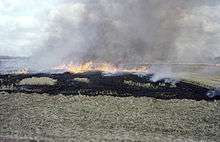Stubble burning
Stubble burning is intentionally setting fire to the straw stubble that remains after grains, like paddy, wheat, etc., have been harvested. The practice was widespread until the 1990s, when governments increasingly restricted its use.
Effects
The burning of stubble, contrasted with alternatives such as ploughing the stubble back into the ground or collecting it for industrial uses, has a number of consequences and effects on the environment.[1]
Generally helpful effects
- Kills slugs and other pests.
- Can reduce nitrogen tie-up
Generally harmful effects
- Loss of nutrients
- Pollution from smoke
- Damage to electrical and electronic equipment from floating threads of conducting waste
- Risk of fires spreading out of control[2]
The main adverse effects of crop residue burning include the emission of greenhouse gases (GHGs) that contributes to the global warming, increased levels of particulate matter (PM) and smog that cause health hazards, loss of biodiversity of agricultural lands, and the deterioration of soil fertility [3]
Attitudes to stubble burning
- Stubble burning has been effectively prohibited since 1993 in England and Wales.[4] A perceived increase in blackgrass, and particularly herbicide resistant blackgrass, has led to a campaign by some arable farmers for its return.[5]
- In Australia stubble burning is "not the preferred option for the majority of farmers"[1] but is permitted and recommended in some circumstances. Farmers are advised to rake and burn windrows, and leave a fire break of 3 metres around any burn off.[2]
- In the United States, fires are fairly common in mid-western states, but some states such as Oregon and Idaho regulate the practice.[6][7]
- In the European Union, the Common Agricultural Policy strongly discourages stubble burning.[8]
- In China, there is a government ban on stubble burning; however the practice remains fairly common.[9]
- In northern India, despite a ban by the Punjab Pollution Control Board, stubble burning is still practiced. Authorities are starting to enforce this ban more proactively.[10][11]
- Stubble burning is allowed by permit in some Canadian provinces, including Manitoba where 5% of farmers were estimated to do it in 2007.[12]
Stubble burning in India
.jpg)
Stubble burning in Punjab and Haryana in northwest India has been cited as a major cause of air pollution in Delhi.[13] Consequently, the government is considering implementation of the 1,600 km long and 5 km wide Great Green Wall of Aravalli.[14] In late September and October each year, farmers mainly in Punjab and Haryana burn an estimated 35 million tons[15] of crop waste from their paddy fields after harvesting as a low-cost straw-disposal practice to reduce the turnaround time between harvesting and sowing for the second (winter) crop.[16] Smoke from this burning produces a cloud of particulates visible from space[17] and has produced what has been described as a "toxic cloud" in New Delhi, resulting in declarations of an air-pollution emergency.[18] For this, the NGT (National Green Tribunal) instituted a fine of Rs. 2,00,000 on the Delhi Government for failing to file an action plan providing incentives and infrastructural assistance to farmers to stop them from burning crop residue to prevent air pollution.[19]
Although harvesters such as the Indian-manufactured "Happy Seeder" that shred the crop residues into small pieces and uniformly spread them across the field are available as an alternative to burning the crops, some farmers complain that the cost of these machines is prohibitive compared to burning the fields.[16]
See also
References
- "Grains and Other Crops» Crop Production» Stubble Burning".
- Ellison, Amelia (August 24, 2013). "Stubble burns cause headache for firebrigades". The Wimmera Mail Times. Retrieved 24 August 2013.
- Zhang, H.; Hu, D.; Chen, J.; Ye, X.; Wang, S. X.; Hao, J. M.; Wang, L.; Zhang, R.; An, Z. (2011). "Particle size distribution and polycyclic aromatic hydrocarbons emissions from agricultural crop residue burning". Environmental Science & Technology. 45 (13): 5477–82. doi:10.1021/es1037904. PMID 21615081.
- "The Crop Residues (Burning) Regulations 1993". www.legislation.gov.uk.
- Tasker, Johann (May 30, 2012). "Farmers step up stubble burning campaign". Retrieved 24 August 2013.
- "Oregon Secretary of State Division Rules, Chapter 603, Division 77, "Field Burning Rules"". Retrieved 4 November 2019.
- Idaho Department of Environmental Quality. "Crop Residue Burning". Retrieved 4 November 2019.
- "REGULATION (EU) No 1306/2013 OF THE EUROPEAN PARLIAMENT AND OF THE COUNCIL".
- "Farmers burn wheat stubble despite ban". Peoples Daily. June 15, 2013. Retrieved 24 August 2013.
- "Paddy stubble burning: Two farmers booked in Sangrur". Hindustan Times. October 31, 2014. Retrieved 23 November 2014.
- Slater, Joanna (October 15, 2018). "India is trying to prevent apocalyptic air pollution. Step 1: Stop farmers from burning their fields". Washington Post. Retrieved 2018-10-17.
- "Smoke from stubble fires engulfs Winnipeg". Canadian Broadcasting Corporation. September 6, 2007.
- Geeta Anand, "Farmers’ Unchecked Crop Burning Fuels India's Air Pollution", The New York Times, Nov. 2, 2016. Retrieved 9 November 2017.
- Want govt to build 1600 km green wall along Aravalli, Indian Express, 24 December 2019.
- Joydeep Thakur, Brace for air pollution in Delhi as crop burning starts in neighbouring states: Agricultural stubble running into millions of tonnes is burnt by farmers in northern India every October. An estimated 35 million tonnes are set afire in Punjab and Haryana alone. Hindustan Times, Sep 28, 2017. Retrieved 9 November 2017.
- Sowmiya Ashok, "Agricultural pollution: The fields are still burning", The Indian Express, October 19, 2017. Retrieved 9 November 2017.
- NASA, "Stubble Burning in Northern India", Earth Observatory. Retrieved 9 November 2017.
- Sanjeev Miglani and Aditya Kalra, "New Delhi declares emergency as toxic smog thickens by the hour", Reuters, Nov. 9, 2017. Retrieved 9 November 2017.
- "Crop burning: NGT slaps Rs 2 lakh as costs on Delhi govt for not filing action plan". Hindustan Times. 2018-04-03. Retrieved 2018-06-26.
